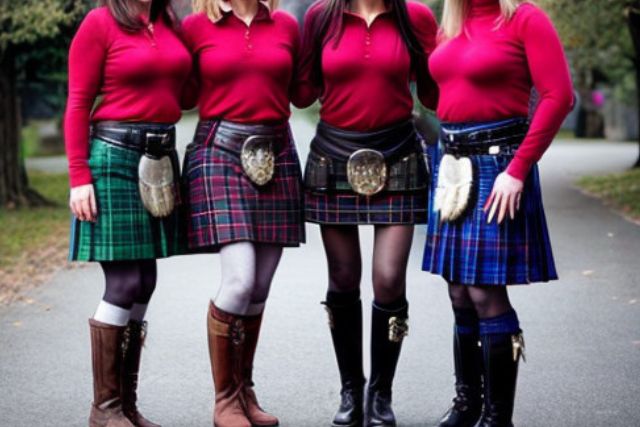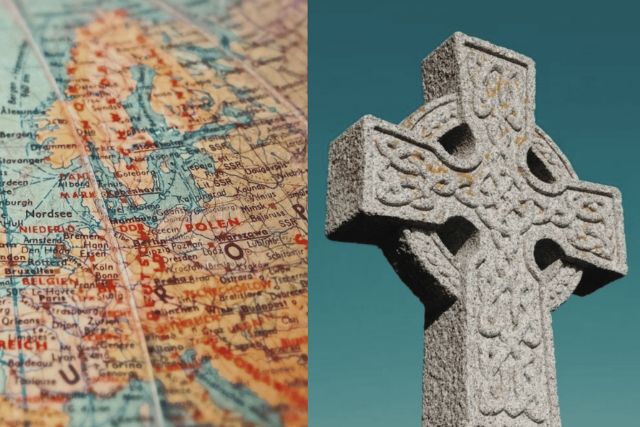The Subtle Elegance of the Kilt Pin
The kilt, a garment steeped in history and tradition, is often the centerpiece of Scottish attire. While the tartan itself commands attention, it’s the smaller, often overlooked details that truly complete the ensemble. Among these, the kilt pin stands out as both a functional accessory and a powerful statement of personal style. More than just a decorative flourish, a kilt pin serves a practical purpose, adding weight to the front apron of the kilt to prevent it from flapping open, especially in breezy conditions. It’s a subtle yet significant element that can elevate your entire look, reflecting your heritage, personality, and the formality of the occasion.
At scottfashion.com, we understand the importance of every detail in traditional Scottish dress. This comprehensive guide will walk you through everything you need to know about choosing the perfect kilt pin, ensuring your outfit is not only authentic but also impeccably styled. Whether you’re a seasoned kilt wearer or new to the world of Highland attire, our insights will help you make an informed decision that complements your kilt and expresses your unique identity.
Understanding the Role of a Kilt Pin: Function Meets Fashion
Before diving into the myriad of choices available, it’s essential to grasp the dual role of the kilt pin. Its primary function is practical: to add a small amount of weight to the outer apron of the kilt, preventing it from being caught by the wind and revealing the under-apron. This is why it’s typically placed on the lower right-hand side of the front apron, pinned only through the top layer of fabric. It should never be pinned through both aprons, as this can restrict the kilt’s natural movement and potentially damage the fabric.
Beyond its utility, the kilt pin is a significant decorative element. It’s an opportunity to infuse your outfit with personal meaning, whether through a symbol of your clan, a representation of your interests, or simply a design that appeals to your aesthetic. The right kilt pin can tie together the various elements of your Highland dress, creating a cohesive and polished appearance. It’s a small detail that speaks volumes about your attention to tradition and style.
Exploring the Diverse World of Kilt Pin Designs
Kilt pins come in an astonishing array of designs, each offering a unique aesthetic and symbolic value. Understanding these categories will help you narrow down your choices and find a pin that truly resonates with you.
Clan Crest Kilt Pins
For those with Scottish heritage, a clan crest kilt pin is a powerful way to display your lineage and pride. These pins feature the specific crest associated with your family’s clan, often surrounded by a belt and buckle motif with the clan motto. They are a timeless and deeply personal choice, connecting you to centuries of Scottish history. If you’re unsure of your clan, a quick search can often reveal your ancestral ties. Wearing your clan crest is a statement of identity and belonging.
Traditional Scottish Symbols
Beyond clan crests, many kilt pins feature iconic Scottish symbols that evoke the spirit of the nation. These include:
- Thistle: Scotland’s national flower, symbolizing resilience and defiance.
- Lion Rampant: A powerful and ancient symbol of Scottish royalty and strength.
- Celtic Knots: Intricate, interwoven patterns representing eternity, interconnectedness, and the enduring nature of Celtic culture.
- Scottish Saltire (St. Andrew’s Cross): The national flag of Scotland, a simple yet potent symbol of national identity.
- Sword or Dagger Designs: Reflecting the martial history of the Highlands, these designs often incorporate traditional Scottish weaponry
These pins are excellent choices for anyone who wishes to celebrate Scottish culture, regardless of specific clan affiliation.
Animal and Nature-Inspired Designs
Many kilt pins draw inspiration from Scotland’s rich wildlife and natural landscapes. Popular choices include:
- Stags/Deer: Symbolizing nobility, grace, and the wild beauty of the Highlands.
- Eagles: Representing strength, freedom, and a connection to the majestic Scottish skies.
- Salmon: A symbol of wisdom and prosperity, often found in Celtic art.
- Abstract Nature Motifs: Designs that subtly incorporate elements like leaves, trees, or flowing water.
Modern and Novelty Kilt Pins
While tradition is central to kilt wearing, there’s also room for contemporary expression. Modern kilt pins often feature sleek, minimalist designs, or incorporate unique materials and artistic interpretations. Novelty pins might include humorous elements, pop culture references, or designs that reflect personal hobbies and interests. These are perfect for those looking to add a touch of individuality and fun to their kilt outfit, especially for less formal occasions.
Materials and Finishes: Adding to the Allure
The material and finish of your kilt pin significantly impact its appearance and durability. Common materials include:
- Pewter: A popular and affordable choice, pewter pins often have an antique or matte finish, giving them a classic, understated look. They are durable and easy to maintain.
- Sterling Silver: For a more luxurious and refined option, sterling silver pins offer a brilliant shine and a timeless elegance. They are often more intricately detailed and can be polished to maintain their luster.
- Brass: Brass pins can range from polished gold-like finishes to antique patinas, offering a versatile aesthetic. They are durable and develop a unique character over time.
- Chrome/Polished Steel: These materials provide a contemporary, high-shine finish, perfect for modern kilt outfits or those seeking a sleek look.
Consider how the material and finish will complement your other accessories, such as your sporran cantle, belt buckle, and sgian dubh, to create a harmonious overall look.
Choosing Your Perfect Kilt Pin:
Selecting the right kilt pin involves more than just picking a design you like. Here are crucial factors to consider:
Occasion and Formality
The formality of the event should guide your choice. For highly formal occasions like weddings or black-tie events, a more traditional and elegant kilt pin, perhaps in sterling silver with a classic Scottish symbol or clan crest, would be appropriate. For casual gatherings, festivals, or everyday wear, you have more freedom to experiment with modern, novelty, or more understated designs.
Coordinating with Your Outfit
Your kilt pin should complement, not clash with, the rest of your Highland dress. Consider:
- Metal Finishes: Try to match the metal finish of your kilt pin with your sporran cantle, belt buckle, and sgian dubh. If your sporran has a chrome cantle, a chrome or polished steel kilt pin would be a good match. If it’s antique brass, an antique pewter or brass pin would be more suitable.
- Overall Style: If your kilt outfit is very traditional, a classic kilt pin will fit best. For a more contemporary look, a modern design might be ideal.
- Tartan Pattern: While not strictly necessary to match the kilt pin to the tartan, ensure the pin’s design doesn’t get lost in a busy tartan or overwhelm a subtle one. The pin should stand out just enough to be noticed.
Size and Placement
Kilt pins typically range from 2.5 to 4 inches in length. A good guideline is to choose a size that is noticeable but not overwhelming. As for placement, the kilt pin is traditionally worn on the lower right-hand side of the kilt’s front apron, approximately 2-3 inches from the bottom hem and 1-2 inches from the fringed edge. Remember, it only goes through the top layer of fabric.
Personal Expression and Meaning
Ultimately, your kilt pin is a reflection of you. Do you want to honor your heritage with a clan crest? Express your love for Scottish wildlife? Or simply add a touch of unique flair? Choose a pin that holds personal significance or simply brings you joy. This personal connection will make your kilt outfit truly yours.
Tips for Maintaining Your Kilt Pin
To ensure your kilt pin remains a cherished part of your Highland attire for years to come, proper care is essential:
- Cleaning: Gently wipe your kilt pin with a soft, dry cloth after each use to remove any oils or dirt. For sterling silver, use a silver polishing cloth to maintain its shine. Avoid harsh chemicals or abrasive cleaners.
- Storage: Store your kilt pin in a soft pouch or a jewelry box to prevent scratches and tarnishing. Keep it separate from other metal items that could rub against it.
- Handling: Always handle your kilt pin by its edges or the main body to avoid bending delicate parts or leaving fingerprints on polished surfaces.
Frequently Asked Questions
What is the purpose of a kilt pin?
A kilt pin serves two main purposes: it adds weight to the outer apron of the kilt to prevent it from flapping open in the wind, and it acts as a decorative accessory to enhance the overall look of the kilt outfit.
Where do you wear a kilt pin?
The kilt pin is traditionally worn on the lower right-hand side of the kilt’s front apron. It should be pinned only through the top layer of fabric, approximately 2-3 inches from the bottom hem and 1-2 inches from the fringed edge.
Can I use any pin as a kilt pin?
While you could technically use any pin, a dedicated kilt pin is designed to complement the kilt’s aesthetic and provide the necessary weight. Using an inappropriate pin might not achieve the desired effect or could even damage the kilt fabric.
How do I choose a kilt pin that matches my outfit?
Consider the formality of the occasion, the metal finishes of your other accessories (sporran, belt buckle, sgian dubh), and your personal style. Aim for a cohesive look where the kilt pin enhances, rather than detracts from, your overall ensemble.
Are kilt pins only for men?
Traditionally, kilt pins are associated with men’s Highland dress. However, women wearing kilts or kilted skirts can also use kilt pins as a decorative accessory, following similar principles of placement and style.



